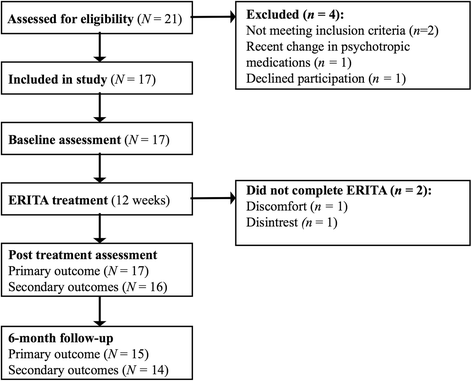Emotion regulation individual therapy for adolescents with nonsuicidal self-injury disorder: a feasibility study
- PMID: 29282024
- PMCID: PMC5745918
- DOI: 10.1186/s12888-017-1527-4
Emotion regulation individual therapy for adolescents with nonsuicidal self-injury disorder: a feasibility study
Abstract
Background: Nonsuicidal self-injury (NSSI) is a serious health risk behavior that forms the basis of a tentative diagnosis in DSM-5, NSSI Disorder (NSSID). To date, established treatments specific to NSSI or NSSID are scarce. As a first step in evaluating the feasibility, acceptability, and utility of a novel treatment for adolescents with NSSID, we conducted an open trial of emotion regulation individual therapy for adolescents (ERITA): a 12-week, behavioral treatment aimed at directly targeting both NSSI and its proposed underlying mechanism of emotion regulation difficulties.
Methods: Seventeen girls (aged 13-17; mean = 15.31) with NSSID were enrolled in a study adopting an uncontrolled open trial design with self-report and clinician-rated assessments of NSSI and other self-destructive behaviors, emotion regulation difficulties, borderline personality features, and global functioning administered at pre-treatment, post-treatment, and 6-month follow-up. Measures of NSSI and emotion regulation difficulties were also administered weekly during treatment.
Results: Ratings of treatment credibility and expectancy and the treatment completion rate (88%) were satisfactory, and both therapeutic alliance and treatment attendance were strong. Intent-to-treat analyses revealed significant improvements associated with large effect sizes in past-month NSSI frequency, emotion regulation difficulties, self-destructive behaviors, and global functioning, as well as a medium effect size in past-month NSSI versatility, from pre- to post-treatment. Further, all of these improvements were either maintained or further improved upon at 6-month follow-up. Finally, change in emotion regulation difficulties mediated improvements in NSSI over the course of treatment.
Conclusions: Results suggest the acceptability, feasibility, and utility of this treatment for adolescents with NSSID.
Trial registration: ClinicalTrials.gov (NCT02326012, December 22, 2014, retrospectively registered).
Keywords: Emotion regulation; Emotion regulation individual therapy; Mediation; Nonsuicidal self-injury disorder; Self-harm.
Conflict of interest statement
Ethics approval and consent to participate
All participants were informed about the study in a way that they could understand. Both (if two) legal guardians provided written consent on behalf of minors aged 14 and younger. In accordance with Swedish law and as specifically instructed in the ethics approval for the study, minors of age 15 and older provided written informed consent if judged to be sufficiently mature; otherwise, legal guardians(s) provided written consent on their child’s behalf. All participating parents provided written informed consent for their own participation. The study was approved by the Regional Ethical Review Board in Stockholm in February 2014 (ref nr 2014/1–31/3).
Consent for publication
No individual details, images or videos on participants were included in this manuscript, thus specific consent for publication was not deemed necessary.
Competing interests
JB, HS, KLG, MTT, JB, JJ and CH report no competing interests. EH and BL are shareholders of a company, Dahlia, used for psychiatric symptom assessment.
Publisher’s Note
Springer Nature remains neutral with regard to jurisdictional claims in published maps and institutional affiliations.
Figures
References
-
- International Society for the Study of Self-Injury. Fast facts. 2017. http://itriples.org/redesadmin15/fast-facts/. Accessed 16 Aug 2017.
-
- American Psychiatric Association. Diagnostic and statistical manual of mental disorders. 5 ed. Washington, DC: Author; 2013.
Publication types
MeSH terms
Associated data
Grants and funding
LinkOut - more resources
Full Text Sources
Other Literature Sources
Medical
Research Materials
Miscellaneous



